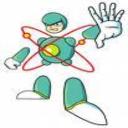Physics 1301A/B Lecture 5: Physics of Motion
53 views2 pages
7 Dec 2017
School
Department
Course
Professor
Document Summary
Distance the length travelled along a path, no matter the shape of the path (scalar). Displacement the change in your position from start to finish (vector). Speed the distance travelled in a certain time (does not involve direction). Velocity the displacement in a certain time (always involves direction). *the derivative of position with respect to time. Average velocity change in position (displacement) over change in time. Instantaneous velocity the velocity at one particular moment (find using derivative). Acceleration change in velocity with respect to time. *the derivative of velocity with respect to time. = (cid:1872)=(cid:2870) (cid:2869) (cid:1872)(cid:2870) (cid:1872)(cid:2869: any and all objects in freefall accelerate downwards at 9. 8 m/s(cid:2870, =(cid:891). (cid:890) /(cid:1871)(cid:2870, we often choose the up direction as positive, so = = (cid:891). (cid:890) /(cid:1871)(cid:2870) Instantaneous acceleration: acceleration is the derivative of velocity with respect to time. It is the second derivative of position with respect to time.







